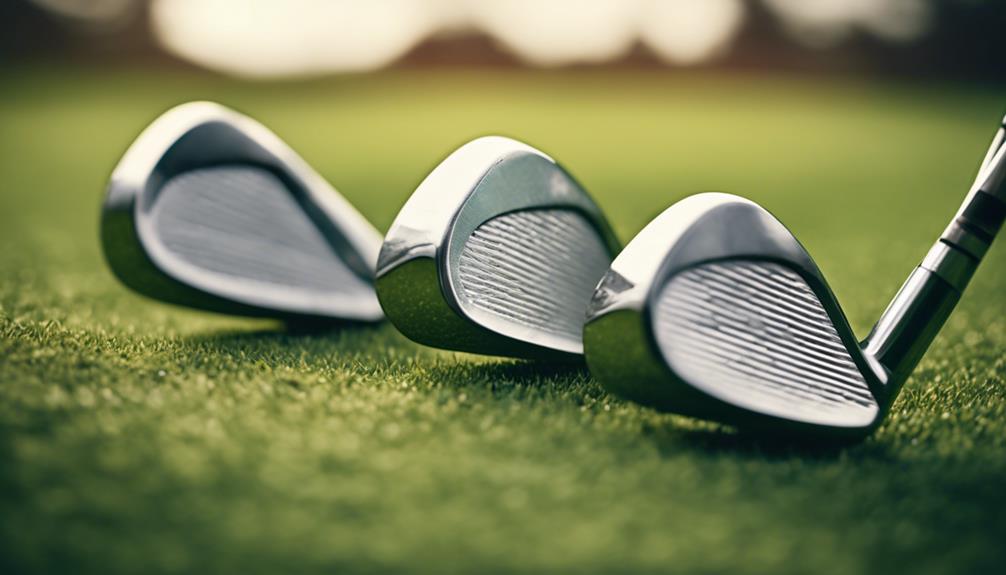- 7 Top Flite Golf Clubs XL for Improved Performance - September 28, 2024
- Top Flite Golf Clubs: Top 5 Reasons to Choose Them - September 28, 2024
- Top 3 Golf Club Fitters for a Perfect Swing - September 28, 2024
You're taking the first step towards short game mastery by exploring the PW golf club. As a beginner, it is crucial to understand the importance of carrying a pitching wedge and sand wedge for effective short game management. The pitching wedge, with a loft of 42-47 degrees, is ideal for high trajectory shots, while the sand wedge, with a loft of 54-57 degrees, excels at bunker escapes and thick rough. As you continue to refine your short game strategy, you'll discover how to master distance and shot precision with the right wedge selection, ultimately leading you to shave strokes off your score.
Key Takeaways
- As a beginner, prioritize carrying a pitching wedge (42-47 degrees) and sand wedge (54-57 degrees) for short game mastery.
- Understand the loft differences between wedges to manage distance effectively, with a 1-degree difference affecting shot height and landing distance.
- Develop precise control and understanding of loft options to achieve 2-3 distinct distances per wedge through swing adjustments.
- Familiarize yourself with the characteristics of each wedge type, including pitching wedge, gap wedge, sand wedge, and lob wedge, to build confidence.
Wedge Essentials for Beginners
When building your PW Golf Club set, start by selecting the right wedges, as they're essential for mastering short-game shots around the greens. Beginners should prioritize carrying at least a pitching wedge and a sand wedge.
These two types of wedges will help you effectively manage your short game, allowing you to score efficiently on the course. A pitching wedge, with a loft range of 42-47 degrees, is ideal for shots requiring a higher trajectory, while a sand wedge, with a loft range of 54-57 degrees, is perfect for getting out of bunkers and maneuvering through thick rough.
Consider adding a gap wedge, with a loft between 49-53 degrees, to fill distance gaps between your pitching and sand wedges, offering more versatility for various shot types.
Choosing the Right Wedge
When choosing the right wedge, you'll want to reflect on several key factors, including the loft range, which can greatly impact your shot's trajectory and distance.
You'll need to decide which types of wedges to carry in your bag, and how to space them out for ideal performance.
Wedge Selection Factors
Choosing the right wedge is essential, as it can make all the difference in your short game. Getting it wrong can leave you struggling to escape bunkers and navigate tricky approach shots.
When it comes to wedge selection factors, you'll want to take into account a few key things. First, think about the loft degree – having a range of 3-6 degrees between wedges allows for ideal distance management and shot versatility.
As a beginner, you should start with at least a pitching wedge and a sand wedge, as these clubs provide essential coverage for both approach shots and bunker play.
The bounce angle of a wedge is also important, as it affects how it interacts with the turf. Higher bounce is beneficial for softer ground conditions, while lower bounce is better for firmer surfaces.
Wedge Loft Explained
As you build your wedge arsenal, you'll quickly realize that loft is a critical factor in selecting the right club for the job. Wedge loft refers to the angle of the clubface, which directly impacts the trajectory and distance of the shot. Higher lofts produce higher shots that travel shorter distances, making precise selection critical for effective play.
Common wedge lofts include the pitching wedge (42-47 degrees), gap wedge (49-53 degrees), sand wedge (54-57 degrees), and lob wedge (58-64 degrees), each serving a specific purpose in the short game. A 1-degree difference in loft can greatly affect performance, altering the shot height and landing distance.
As a beginner, it's important to start with a pitching wedge and sand wedge, as these provide a versatile range of lofts suitable for many short-game situations. Understanding the appropriate loft for various distances allows you to strategically select wedges to cover gaps in your shot range, enhancing overall performance.
Wedge Types and Characteristics

Let's plunge into the world of wedges, where mastering the right club can make all the difference in your short game. You'll encounter four primary wedge types, each with its unique characteristics.
The Pitching Wedge (PW) has a loft of 42-47 degrees, ideal for approach shots.
The Gap Wedge (GW) fills the distance gap with a loft of 49-53 degrees.
The Sand Wedge (SW) is a versatile club with a loft of 54-57 degrees, perfect for bunker play and short approach shots.
Finally, the Lob Wedge (LW) has a loft ranging from 58-64 degrees, designed for high, short shots around the green.
As a beginner, it's recommended to start with at least a PW and SW, as these provide versatility for various short game situations.
Understanding the loft differences between wedges is essential for effective distance management and shot selection.
With the right wedge in your bag, you'll be well-equipped to tackle any short game challenge that comes your way.
ONE Wedge Innovation and Benefits
Take your short game to the next level with the ONE Wedge, a revolutionary innovation that streamlines your setup while maintaining versatility and precision. By replacing either a lob wedge or gap wedge, you'll simplify your golf set and focus on mastering your wedge game.
The ONE Wedge's Pitch Control Technology guarantees consistent results on pitch shots, allowing you to confidently navigate tricky greenside shots. As a beginner, you'll appreciate the ONE Wedge's ability to comply with golf course regulations, making it suitable for both practice and competitive play.
This innovative wedge is designed to improve your overall performance, aiming to reduce your average golf score by 7-9 shots. By targeting improved distance management, you'll better map your shot distances for enhanced accuracy around the greens.
The ONE Wedge is among the best golf wedges for beginners, offering a straightforward approach to mastering your short game. As you explore the world of golf, the ONE Wedge will become an essential component of your golf set, helping you to consistently shoot better scores and take your game to the next level.
Mastering Distance With Wedges

As you work on mastering distance with your wedges, you'll want to focus on developing precise control, exploring your loft options, and optimizing your wedge selection for each shot.
By doing so, you'll be able to tackle varying distances with confidence, knowing exactly which wedge to reach for in any situation.
With practice and patience, you'll reveal the full potential of your wedges and start shooting lower scores.
Wedge Distance Control
Mastering distance control with your wedges starts with mapping out the exact yardages you can expect from each club in your bag.
You'll want to know that your pitching wedge can typically reach around 110 yards, while your gap wedge might cover approximately 95 yards, depending on your individual swing speed and technique.
To enhance your wedge game, focus on developing 2-3 distinct distances per wedge by utilizing techniques like choking up or adjusting swing length. This will give you more versatility and control over your shots.
Here are three key takeaways to improve your wedge distance control:
- Loft spacing: Aim for a 3-6 degree loft spacing between wedges to allow for better distance management and shot variety.
- Practice regularly: Regular practice with your wedges, especially focusing on different lies and shot types, can markedly improve your distance control and overall short-game performance.
Wedge Loft Options
By understanding the various loft options available in wedges, you can enhance your club selection to achieve the desired distance and trajectory for any given shot.
As a beginner golfer, it's vital to know that wedges come in different types, each with its unique range of degrees of loft. Pitching wedges typically range from 42-47 degrees, gap wedges from 49-53 degrees, sand wedges from 54-57 degrees, and lob wedges from 58-64 degrees.
A higher loft increases the shot's trajectory while decreasing distance. For example, a sand wedge (54-57 degrees) typically achieves a maximum distance of around 90-100 yards, depending on your swing.
Even a 1-degree difference in loft can greatly impact shot performance, affecting both the height and distance of the ball. Mapping distances for each wedge is imperative, and understanding loft gaps (3-6 degrees between wedges) can greatly enhance your short game by providing ideal distance coverage and shot versatility.
Optimizing Wedge Selection
You'll take your short game to the next level when you optimize your wedge selection, guaranteeing each club in your bag is dialed in to deliver precise distances and trajectories. This is vital, as proper distance management is important for effective short game performance.
To achieve this, it's necessary to map distances for each wedge, understanding that a pitching wedge typically covers around 110 yards, while a gap wedge might be effective at approximately 95 yards.
Here are three key factors to reflect on when optimizing your wedge selection:
- Develop specific distances for each wedge: Enhance versatility by developing 2-3 specific distances for each wedge, allowing you to adjust your swing or grip to achieve the desired yardage.
- Loft spacing is critical: Guarantee spacing between wedges is ideally 3-6 degrees in loft to fill specific distance gaps, promoting a more cohesive short game.
Golf Club Basics and Manufacturers
With a deep understanding of the three main components – the head, shaft, and grip – that make up a golf club, you can better appreciate the craftsmanship that goes into designing and manufacturing a club that suits your unique playing style. As you explore the world of golf, you'll discover that modern golf sets typically include a mix of woods, hybrids, irons, wedges, and putters to cover various playing situations on the course.
| Club Type | Description | Manufacturer Example |
|---|---|---|
| Woods | Long-distance clubs for tee shots | Callaway Golf |
| Hybrids | Versatile clubs for long shots | TaylorMade Golf |
| Irons | Precise clubs for mid-range shots | Ping Golf |
| Wedges | Specialized clubs for high-angle shots | Cleveland Golf |
| Putters | Clubs for rolling the ball on the green | Scotty Cameron |
Golf manufacturers, like Pinemeadow Golf Products, Inc., endeavor to maximize the physics of club design while adhering to strict rules set by golf governing bodies regarding club specifications. As you build your golf bag, you'll likely include a mix of drivers, irons, wedges, and putters tailored to your individual needs. By understanding the craftsmanship behind each club, you'll be better equipped to select the right tools for your game.
Wedge Selection and Psychology

As you assemble your golf bag, selecting the right wedges becomes a critical decision, as these clubs can greatly impact your scoring and shot versatility within 100 yards of the green.
To enhance your short game, contemplate carrying at least a pitching wedge and a sand wedge, as these clubs provide the necessary tools for both approach shots and bunker play.
Here are three key factors to take into account when making your wedge selection:
- Loft degrees: Understanding the loft degrees of wedges, typically ranging from 42 to 64 degrees, helps you manage shot height and distance effectively. Even a 1° loft difference can considerably impact performance.
- Spacing between wedges: Aim for a 3-6 degree spacing between wedges to guarantee ideal distance coverage, allowing for more precise shot selection in various situations.
Track Order and Warranty Information
When purchasing a PW Golf Club, tracking your order online provides a seamless shopping experience, allowing you to stay informed about the status of your delivery. You'll have peace of mind knowing exactly when your new clubs will arrive.
Furthermore, you're protected by a 1-Year Warranty, guaranteeing you have support for any manufacturing defects that may arise.
In addition to tracking your order, our shipping and return policies are clearly outlined, so you know exactly how to return or exchange your clubs if needed.
To further guarantee you get the right fit, our custom fitting wizard is available to guide you in selecting the perfect size and specifications for your clubs.
Plus, you can access Golf Clubs 101 and customer testimonials, providing valuable insights and feedback to help you make informed purchasing decisions.
With PW Golf Club, you can trust that you're getting the best possible experience, from order to delivery and beyond.
Frequently Asked Questions
What Is the Difference Between PW AW SW and Lw?
You'll master your short game by understanding the key differences between PW, AW, SW, and LW wedge types, which boil down to loft differences, affecting shot height and distance, and dictating club selection for ideal shot versatility.
Do I Need a 52-56 and 60 Wedge?
You're trying to cover all your bases, but do you really need a 52-56 and 60 wedge? Cut to the chase – having all three boosts wedge versatility, allowing you to tailor shot selection to course conditions and personal preference, but it's a luxury that demands skill development.
How Many Wedges Should a Beginner Carry?
When selecting wedges, you should prioritize the essentials: a pitching wedge and sand wedge. These beginner equipment essentials will cover your short game strategies, but consider adding a gap wedge to refine your wedge selection tips and avoid common mistakes in club fitting advice.
Do I Need a Sand Wedge and a Pitching Wedge?
You need both a sand wedge and pitching wedge for ideal wedge versatility, allowing you to make informed shot selections and master various lies; proper club fitting and dedicated practice routines will greatly improve your game.
Conclusion
You've finally reached the 19th hole of our beginner's guide, and it's time to tee off into the world of wedges!
As you commence this journey, remember that mastering wedges is like revealing a treasure chest filled with birdies and eagles.
Just as a master blacksmith forges a sword, you'll be crafting your own path to golfing greatness.
So, go forth, wield your wedges wisely, and may the links be ever in your favor!




